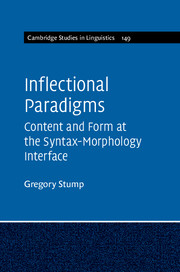Book contents
- Frontmatter
- Dedication
- Contents
- List of figures
- List of tables
- Acknowledgements
- List of abbreviations
- List of symbols and operators
- Introduction
- 1 What are inflectional paradigms?
- 2 Canonical inflectional paradigms
- 3 Morphosyntactic properties
- 4 Lexemes
- 5 Stems
- 6 Inflection classes
- 7 A conception of the relation of content to form in inflectional paradigms
- 8 Morphomic properties
- 9 Too many cells, too few cells
- 10 Syncretism
- 11 Suppletion and heteroclisis
- 12 Deponency and metaconjugation
- 13 Polyfunctionality
- 14 A theoretical synopsis and two further issues
- References
- Index
14 - A theoretical synopsis and two further issues
Published online by Cambridge University Press: 18 December 2015
- Frontmatter
- Dedication
- Contents
- List of figures
- List of tables
- Acknowledgements
- List of abbreviations
- List of symbols and operators
- Introduction
- 1 What are inflectional paradigms?
- 2 Canonical inflectional paradigms
- 3 Morphosyntactic properties
- 4 Lexemes
- 5 Stems
- 6 Inflection classes
- 7 A conception of the relation of content to form in inflectional paradigms
- 8 Morphomic properties
- 9 Too many cells, too few cells
- 10 Syncretism
- 11 Suppletion and heteroclisis
- 12 Deponency and metaconjugation
- 13 Polyfunctionality
- 14 A theoretical synopsis and two further issues
- References
- Index
Summary
My objective in this book has been to elucidate the importance of inflectional paradigms as the interface of a language's inflectional morphology with its syntax and semantics, drawing particular attention to their role in accounting for mismatches between inflectional morphology and the content that it expresses. In this concluding chapter, I present a synopsis of the paradigm-linkage theory developed in Chapters 7 through 13 (Section 14.1) and discuss two issues pertaining to its formulation and application: the prospect of a purely abstractive approach to defining realized paradigms (Section 14.2) and the relevance of the paradigm linkage to understanding morphological change (Section 14.3). I end with a very brief general conclusion (Section 14.4).
A synopsis of the paradigm-linkage theory
The paradigm-linkage theory presented here is an inferential-realizational theory of inflectional morphology, but it possesses several features that set it apart from other such theories (including that of Anderson 1992, Stump 2001 and Brown and Hippisley 2012). It will therefore be useful to synopsize the characteristics of this theory.
The paradigm-linkage theory is built on the assumption that a language's inflectional morphology involves three kinds of paradigms and the relations among them. A lexeme L's content paradigm contains only content, in the form of cells pairing L with different morphosyntactic property sets with which L may be associated in syntax. Where 〈L, σ〉 is such a cell and L belongs to category C, the realization w of 〈L, σ〉 may be inserted as the representative of L into any C node bearing the property set σ; in addition, the semantic content of w is fully determined by 〈L, σ〉. A lexeme's content paradigm is therefore the interface of its word forms with syntax and semantics.
A stem Z's form paradigm contains cells pairing Z (or a kindred stem Zʹ; Section 5.2) with each property set for which Z (or Zʹ) may be inflected. Each form cell in a stem's form paradigm is linked to a content cell in some lexeme's content paradigm; the form cell is in that case the content cell's form correspondent. Where 〈Z, τ〉 is the form correspondent of 〈L, σ〉, the realization of 〈Z, τ〉 is that of 〈L, σ〉.
- Type
- Chapter
- Information
- Inflectional ParadigmsContent and Form at the Syntax-Morphology Interface, pp. 252 - 270Publisher: Cambridge University PressPrint publication year: 2015



